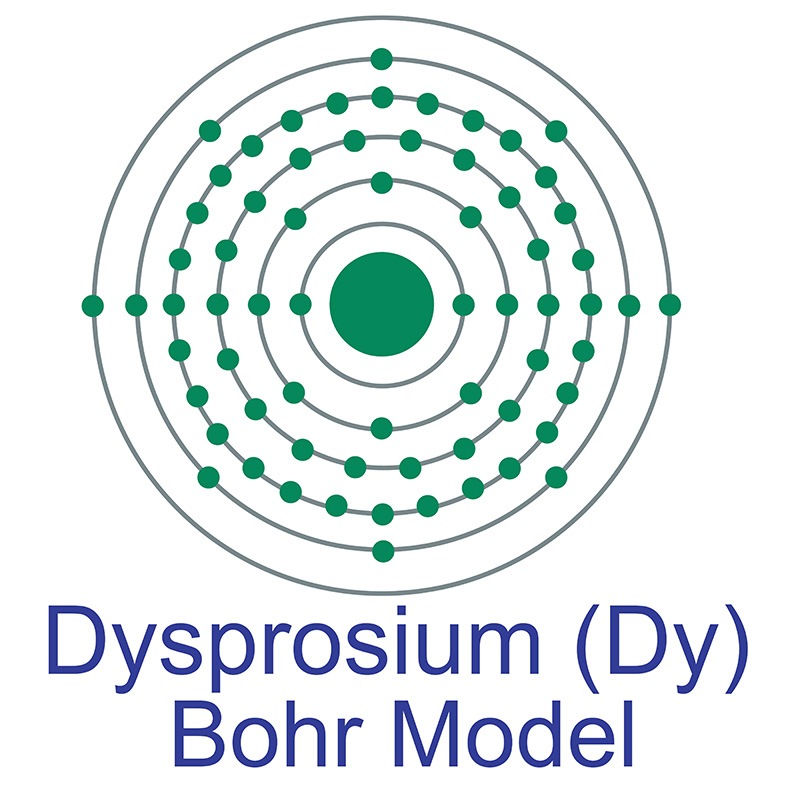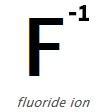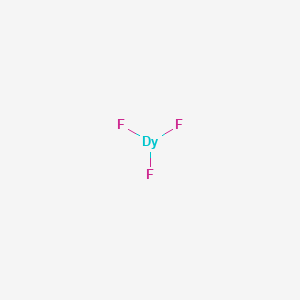SECTION 1. IDENTIFICATION
Product Name: Dysprosium Fluoride
Product Number: All applicable American Elements product codes, e.g. DY-F-02
, DY-F-03
, DY-F-04
, DY-F-05
CAS #: 13569-80-7
Relevant identified uses of the substance: Scientific research and development
Supplier details:
American Elements
10884 Weyburn Ave.
Los Angeles, CA 90024
Tel: +1 310-208-0551
Fax: +1 310-208-0351
Emergency telephone number:
Domestic, North America: +1 800-424-9300
International: +1 703-527-3887
SECTION 2. HAZARDS IDENTIFICATION
2.1 Classification of the substance or mixture
GHS Classification in accordance with 29 CFR 1910 (OSHA HCS)
Skin irritation (Category 2), H315
Eye irritation (Category 2A), H319
Specific target organ toxicity - single exposure (Category 3), Respiratory system, H335
2.2 GHS Label elements, including precautionary statements

Pictogram
Signal word Warning
Hazard statement(s)
H315 Causes skin irritation.
H319 Causes serious eye irritation.
H335 May cause respiratory irritation.
Precautionary statement(s)
P261 Avoid breathing dust/ fume/ gas/ mist/ Vapors/ spray.
P264 Wash skin thoroughly after handling.
P271 Use only outdoors or in a well-ventilated area.
P280 Wear protective gloves/ eye protection/ face protection.
P302 + P352 IF ON SKIN: Wash with plenty of soap and water.
P304 + P340 IF INHALED: Remove victim to fresh air and keep at rest in a position
comfortable for breathing.
P305 + P351 + P338 IF IN EYES: Rinse cautiously with water for several minutes. Remove
contact lenses, if present and easy to do. Continue rinsing.
P312 Call a POISON CENTER/doctor if you feel unwell.
P321 Specific treatment (see supplemental first aid instructions on this label).
P332 + P313 If skin irritation occurs: Get medical advice/ attention.
P337 + P313 If eye irritation persists: Get medical advice/ attention.
P362 Take off contaminated clothing and wash before reuse.
P403 + P233 Store in a well-ventilated place. Keep container tightly closed.
P405 Store locked up.
P501 Dispose of contents/ container to an approved waste disposal plant.
2.3 Hazards not otherwise classified (HNOC) or not covered by GHS
Strong hydrogen fluoride-releaser
SECTION 3. COMPOSITION/INFORMATION ON INGREDIENTS
3.1 Substances
Formula : DyF3
Molecular weight : 219.50 g/mol
CAS-No. : 13569-80-7
EC-No. : 236-992-9
Hazardous components
Component Classification Concentration
Dysprosium trifluoride
Skin Irrit. 2; Eye Irrit. 2A;
STOT SE 3; H315, H319,
H335
<= 100 %
SECTION 4. FIRST AID MEASURES
4.1 Description of first aid measures
General advice
Consult a physician. Show this safety data sheet to the doctor in attendance.Hydrofluoric (HF) acid burns require
immediate and specialized first aid and medical treatment. Symptoms may be delayed up to 24 hours depending on the
concentration of HF. After decontamination with water, further damage can occur due to penetration/absorption of the
fluoride ion. Treatment should be directed toward binding the fluoride ion as well as the effects of exposure. Skin
exposures can be treated with a 2.5% calcium gluconate gel repeated until burning ceases. More serious skin
exposures may require subcutaneous calcium gluconate except for digital areas unless the physician is experienced in
this technique, due to the potential for tissue injury from increased pressure. Absorption can readily occur through the
subungual areas and should be considered when undergoing decontamination. Prevention of absorption of the fluoride
ion in cases of ingestion can be obtained by giving milk, chewable calcium carbonate tablets or Milk of Magnesia to
conscious victims. Conditions such as hypocalcemia, hypomagnesemia and cardiac arrhythmias should be monitored
for, since they can occur after exposure.
If inhaled
If breathed in, move person into fresh air. If not breathing, give artificial respiration. Consult a physician.
In case of skin contact
Wash off with soap and plenty of water. Consult a physician.First treatment with calcium gluconate paste.
In case of eye contact
Rinse thoroughly with plenty of water for at least 15 minutes and consult a physician.
If swallowed
Never give anything by mouth to an unconscious person. Rinse mouth with water. Consult a physician.
4.2 Most important symptoms and effects, both acute and delayed
The most important known symptoms and effects are described in the labelling (see section 2.2) and/or in section 11
4.3 Indication of any immediate medical attention and special treatment needed
No data available
SECTION 5. FIREFIGHTING MEASURES
5.1 Extinguishing media
Suitable extinguishing media
Use water spray, alcohol-resistant foam, dry chemical or carbon dioxide.
5.2 Special hazards arising from the substance or mixture
No data available
5.3 Advice for firefighters
Wear self-contained breathing apparatus for firefighting if necessary.
5.4 Further information
No data available
SECTION 6. ACCIDENTAL RELEASE MEASURES
6.1 Personal precautions, protective equipment and emergency procedures
Use personal protective equipment. Avoid dust formation. Avoid breathing Vapors, mist or gas. Ensure adequate
ventilation. Evacuate personnel to safe areas. Avoid breathing dust.
For personal protection see section 8.
6.2 Environmental precautions
Do not let product enter drains.
6.3 Methods and materials for containment and cleaning up
Pick up and arrange disposal without creating dust. Sweep up and shovel. Keep in suitable, closed containers for
disposal.
6.4 Reference to other sections
For disposal see section 13.
SECTION 7. HANDLING AND STORAGE
7.1 Precautions for safe handling
Avoid contact with skin and eyes. Avoid formation of dust and aerosols.
Provide appropriate exhaust ventilation at places where dust is formed.Normal measures for preventive fire protection.
For precautions see section 2.2.
7.2 Conditions for safe storage, including any incompatibilities
Keep container tightly closed in a dry and well-ventilated place.
Keep in a dry place. Do not store in glass
7.3 Specific end use(s)
Apart from the uses mentioned in section 1.2 no other specific uses are stipulated
SECTION 8. EXPOSURE CONTROLS/PERSONAL PROTECTION
8.1 Control parameters
Components with workplace control parameters
Component CAS-No. Value Control
parameters
Basis
Dysprosium
trifluoride
13569-80-7 TWA 2.500000
mg/m3
USA. Occupational Exposure Limits
(OSHA) - Table Z-1 Limits for Air
Contaminants
Remarks CAS number varies with compound
TWA 2.500000
mg/m3
USA. Occupational Exposure Limits
(OSHA) - Table Z-2
Z37.28-1969
TWA 2.500000
mg/m3
USA. ACGIH Threshold Limit Values
(TLV)
Bone damage
Fluorosis
Substances for which there is a Biological Exposure Index or Indices
(see BEI® section)
Not classifiable as a human carcinogen
varies
TWA 2.500000
mg/m3
USA. ACGIH Threshold Limit Values
(TLV)
Bone damage
Fluorosis
Substances for which there is a Biological Exposure Index or Indices
(see BEI® section)
Not classifiable as a human carcinogen
varies
TWA 2.5 mg/m3 USA. Occupational Exposure Limits
(OSHA) - Table Z-1 Limits for Air
Contaminants
CAS number varies with compound
TWA 2.5 mg/m3 USA. ACGIH Threshold Limit Values
(TLV)
Bone damage
Fluorosis
Substances for which there is a Biological Exposure Index or Indices
(see BEI® section)
Not classifiable as a human carcinogen
varies
Biological occupational exposure limits
Component CAS-No. Parameters Value Biological
specimen
Basis
Dysprosium
trifluoride
13569-80-7 Fluoride 3.0000
mg/g
In urine ACGIH - Biological
Exposure Indices
(BEI)
Remarks Prior to shift (16 hours after exposure ceases)
Fluoride 10.0000
mg/g
In urine ACGIH - Biological
Exposure Indices
(BEI)
End of shift (As soon as possible after exposure ceases)
Fluoride 2 mg/l Urine ACGIH - Biological
Exposure Indices
(BEI)
Prior to shift (16 hours after exposure ceases)
Fluoride 3 mg/l Urine ACGIH - Biological
Exposure Indices
(BEI)
End of shift (As soon as possible after exposure ceases)
8.2 Exposure controls
Appropriate engineering controls
Handle in accordance with good industrial hygiene and safety practice. Wash hands before breaks and at the end of
workday.
Personal protective equipment
Eye/face protection
Safety glasses with side-shields conforming to EN166 Use equipment for eye protection tested and approved
under appropriate government standards such as NIOSH (US) or EN 166(EU).
Skin protection
Handle with gloves. Gloves must be inspected prior to use. Use proper glove removal technique (without
touching glove's outer surface) to avoid skin contact with this product. Dispose of contaminated gloves after
use in accordance with applicable laws and good laboratory practices. Wash and dry hands.
Body Protection
Impervious clothing, The type of protective equipment must be selected according to the concentration and
amount of the dangerous substance at the specific workplace.
Respiratory protection
For nuisance exposures use type P95 (US) or type P1 (EU EN 143) particle respirator.For higher level
protection use type OV/AG/P99 (US) or type ABEK-P2 (EU EN 143) respirator cartridges. Use respirators and
components tested and approved under appropriate government standards such as NIOSH (US) or CEN (EU).
Control of environmental exposure
Do not let product enter drains.
SECTION 9. PHYSICAL AND CHEMICAL PROPERTIES
9.1 Information on basic physical and chemical properties
a) Appearance Form: powder
b) Odor No data available
c) Odor Threshold No data available
d) pH No data available
e) Melting point/freezing
point
No data available
f) Initial boiling point and
boiling range
No data available
g) Flash point N/A
h) Evaporation rate No data available
i) Flammability (solid, gas) No data available
j) Upper/lower
flammability or
explosive limits
No data available
k) Vapor pressure No data available
l) Vapor density No data available
m) Relative density No data available
n) Water solubility No data available
o) Partition coefficient: noctanol/
water
No data available
p) Auto-ignition
temperature
No data available
q) Decomposition
temperature
No data available
r) Viscosity No data available
s) Explosive properties No data available
t) Oxidizing properties No data available
9.2 Other safety information
No data available
SECTION 10. STABILITY AND REACTIVITY
10.1 Reactivity
No data available
10.2 Chemical stability
Stable under recommended storage conditions.
10.3 Possibility of hazardous reactions
No data available
10.4 Conditions to avoid
Avoid moisture.
Reacts dangerously with glass.
10.5 Incompatible materials
Strong oxidizing agentsglass
10.6 Hazardous decomposition products
Hazardous decomposition products formed under fire conditions. - Hydrogen fluoride, Metal oxides
Other decomposition products - No data available
In the event of fire: see section 5
SECTION 11. TOXICOLOGICAL INFORMATION
11.1 Information on toxicological effects
Acute toxicity
No data available
Inhalation: No data available
Dermal: No data available
No data available
Skin corrosion/irritation
No data available
Serious eye damage/eye irritation
No data available
Respiratory or skin sensitisation
No data available
Germ cell mutagenicity
No data available
Carcinogenicity
IARC: 3 - Group 3: Not classifiable as to its carcinogenicity to humans (Dysprosium trifluoride)
NTP: No component of this product present at levels greater than or equal to 0.1% is identified as a
known or anticipated carcinogen by NTP.
OSHA: No component of this product present at levels greater than or equal to 0.1% is identified as a
carcinogen or potential carcinogen by OSHA.
Reproductive toxicity
No data available
No data available
Specific target organ toxicity - single exposure
Inhalation - May cause respiratory irritation.
Specific target organ toxicity - repeated exposure
No data available
Aspiration hazard
No data available
Additional Information
RTECS: Not available
Fluoride ion can reduce serum calcium levels possibly causing fatal hypocalcemia.
To the best of our knowledge, the chemical, physical, and toxicological properties have not been thoroughly
investigated., Rare earth compounds may cause delayed blood clotting leading to hemorrhages. Inhalation of rare
earths may cause sensitivity to heat, itching, and increased awareness of odor and taste.
SECTION 12. ECOLOGICAL INFORMATION
12.1 Toxicity
No data available
12.2 Persistence and degradability
No data available
12.3 Bioaccumulative potential
No data available
12.4 Mobility in soil
No data available
12.5 Results of PBT and vPvB assessment
PBT/vPvB assessment not available as chemical safety assessment not required/not conducted
12.6 Other adverse effects
No data available
SECTION 13. DISPOSAL CONSIDERATIONS
13.1 Waste treatment methods
Product
Offer surplus and non-recyclable solutions to a licensed disposal company.
Contaminated packaging
Dispose of as unused product.
SECTION 14. TRANSPORT INFORMATION
DOT (US)
Not dangerous goods
IMDG
Not dangerous goods
IATA
Not dangerous goods
SECTION 15. REGULATORY INFORMATION
SARA 302 Components
No chemicals in this material are subject to the reporting requirements of SARA Title III, Section 302.
SARA 313 Components
This material does not contain any chemical components with known CAS numbers that exceed the threshold (De
Minimis) reporting levels established by SARA Title III, Section 313.
SARA 311/312 Hazards
Acute Health Hazard
Massachusetts Right To Know Components
No components are subject to the Massachusetts Right to Know Act.
Pennsylvania Right To Know Components
Dysprosium trifluoride
CAS-No.
13569-80-7
New Jersey Right To Know Components
Dysprosium trifluoride
CAS-No.
13569-80-7
Revision Date
2008-06-01
California Prop. 65 Components
This product does not contain any chemicals known to State of California to cause cancer, birth defects, or any other
reproductive harm.
SECTION 16. OTHER INFORMATION
Safety Data Sheet according to Regulation (EC) No. 1907/2006 (REACH). The above information is believed to be correct but does not purport to be all inclusive and shall be used only as a guide. The information in this document is based on the present state of our knowledge and is applicable to the product with regard to appropriate safety precautions. It does not represent any guarantee of the properties of the product. American Elements shall not be held liable for any damage resulting from handling or from contact with the above product. See reverse side of invoice or packing slip for additional terms and conditions of sale. COPYRIGHT 1997-2022 AMERICAN ELEMENTS. LICENSED GRANTED TO MAKE UNLIMITED PAPER COPIES FOR INTERNAL USE ONLY.
 The number of electrons in each of dysprosium's shells is [2, 8, 18, 28, 8, 2] and its electron configuration is [Xe]4f10 6s2. The dysprosium atom has an atomic radius of 178 pm and a Van der Waals radius of 229 pm. Dysprosium was first discovered by Paul Emile Lecoq de Boisbaudran in 1886. In its elemental form, dysprosium has a silvery-white appearance.
The number of electrons in each of dysprosium's shells is [2, 8, 18, 28, 8, 2] and its electron configuration is [Xe]4f10 6s2. The dysprosium atom has an atomic radius of 178 pm and a Van der Waals radius of 229 pm. Dysprosium was first discovered by Paul Emile Lecoq de Boisbaudran in 1886. In its elemental form, dysprosium has a silvery-white appearance.  It is a member of the lanthanide or rare earth series of elements and, along with holmium, has the highest magnetic strength of all other elements on the periodic table, especially at low temperatures. Dysprosium is found in various minerals including bastnäsite, blomstrandine, euxenite, fergusonite, gadolinite, monazite, polycrase and xenotime. It is not found in nature as a free element. The element name originates from the Greek word dysprositos, meaning hard to get at.
It is a member of the lanthanide or rare earth series of elements and, along with holmium, has the highest magnetic strength of all other elements on the periodic table, especially at low temperatures. Dysprosium is found in various minerals including bastnäsite, blomstrandine, euxenite, fergusonite, gadolinite, monazite, polycrase and xenotime. It is not found in nature as a free element. The element name originates from the Greek word dysprositos, meaning hard to get at.

